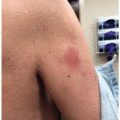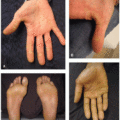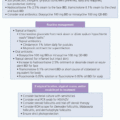BRAF Inhibitors
Jordan Talia
Christine M. Cornejo
Jesse Hirner
BRAF is an oncogene encoding the BRAF protein, a component of the MAPK signaling pathway, that regulates cell proliferation, differentiation, survival, and apoptosis. BRAF mutations play a role in a number of cancers.1,2,3,4 The three currently approved BRAF inhibitors are vemurafenib, dabrafenib, and encorafenib. When treating melanoma, these drugs are often paired with MEK inhibitors. The doublet reduces the risk of cutaneous adverse events, particularly squamous neoplasms, compared to BRAF monotherapy5; dAEs with BRAF monotherapy appear to be primarily driven by paradoxical activation of the MAPK cascade through CRAF and independent pathways. The occurrence of rash in patients treated with vemurafenib does not appear to correlate with tumor response,1 but the presence of severe cutaneous adverse events in a cohort of patients receiving either vemurafenib or dabrafenib was associated with improved survival.3 BRAF inhibitors continue to be used as monotherapy in the treatment of several hematologic disorders harboring targetable mutations (ie, hairy cell leukemia, histiocytic disorders). Cutaneous adverse events associated with this class include photosensitivity, inflammatory disorders, hair and nail changes, and toxicities of epidermal proliferation.
Photosensitivity (Figure 29.1) is more common with vemurafenib than dabrafenib or encorafenib, where it occurs in 23% to 67% of patients.1,2,4 In contrast, it occurs in approximately 17% of patients receiving dabrafenib.2 Risk can be reduced by strict sun protection, although this does not prevent all photosensitive reactions.4 This is thought to be a UVA-mediated process, and thus, broad-spectrum sun protection, ideally with physical blockers and sun protective clothing, is ideal. Of note, UVA can penetrate some window glass, and therefore, daily sunscreen is recommended.
Inflammatory disorders from BRAF inhibitors can include maculopapular/morbilliform exanthema and acneiform/papulopustular eruptions and xerosis that may progress to dermatitis.1,2,4 The morbilliform eruption associated with BRAF inhibitors is usually grade 1 to 2, is often transient, occurring within the first 2 to 4weeks, and self-resolving. Symptomatic eruptions are most often able to be managed with topical steroids.1,4,5 One study found that 59% of grade 1 eruptions resolved without drug discontinuation or dose modification.1 More severe eruptions may necessitate systemic steroids.5 Grade 3 to 4
cutaneous side effects occur in 26% of patients,3 including rare reports of drug reaction with eosinophilia and systemic symptoms syndrome and Stevens-Johnson syndrome/toxic epidermal necrolysis.1,3 Treatment discontinuation is required for serious reactions. In one series, 9 of 10 patients with grade 3 to 4 cutaneous toxicity on vemurafenib who switched to dabrafenib tolerated it well.3 Papulopustular eruptions are less common, may present more diffusely than similar eruptions seen with EGFRi (Figure 29.2), and can be managed with topical steroids. While retinoids tend to be too drying to use in the care of EGFRi patients,
BRAFi patients tend to tolerate these. Topical tretinoin 0.05% cream (using higher or lower concentrations as tolerated by the patient) can be beneficial. For refractory or wide spread involvement, low-dose acitretin (10mg QOD-QD) or isotretinoin (10-20mg daily) is usually beneficial and may also treat the lesions of disordered keratinocyte proliferation (below). Xerosis is common and can be managed with moisturizers.3,5 It can become severe and lead to eczematous dermatitis which is responsive to topical steroids. Erythema
nodosum (EN) occurs in some patients,1,2,4 as does keratosis pilaris (KP) (Figure 29.3). EN is generally responsive to nonsteroidal anti-inflammatories, topical, or oral low-dose steroids (5-10 mg prednisone daily). KP tends to respond to topical keratolytics and topical retinoids, with topical steroids reserved for symptomatic cases.
cutaneous side effects occur in 26% of patients,3 including rare reports of drug reaction with eosinophilia and systemic symptoms syndrome and Stevens-Johnson syndrome/toxic epidermal necrolysis.1,3 Treatment discontinuation is required for serious reactions. In one series, 9 of 10 patients with grade 3 to 4 cutaneous toxicity on vemurafenib who switched to dabrafenib tolerated it well.3 Papulopustular eruptions are less common, may present more diffusely than similar eruptions seen with EGFRi (Figure 29.2), and can be managed with topical steroids. While retinoids tend to be too drying to use in the care of EGFRi patients,
BRAFi patients tend to tolerate these. Topical tretinoin 0.05% cream (using higher or lower concentrations as tolerated by the patient) can be beneficial. For refractory or wide spread involvement, low-dose acitretin (10mg QOD-QD) or isotretinoin (10-20mg daily) is usually beneficial and may also treat the lesions of disordered keratinocyte proliferation (below). Xerosis is common and can be managed with moisturizers.3,5 It can become severe and lead to eczematous dermatitis which is responsive to topical steroids. Erythema
nodosum (EN) occurs in some patients,1,2,4 as does keratosis pilaris (KP) (Figure 29.3). EN is generally responsive to nonsteroidal anti-inflammatories, topical, or oral low-dose steroids (5-10 mg prednisone daily). KP tends to respond to topical keratolytics and topical retinoids, with topical steroids reserved for symptomatic cases.
Stay updated, free articles. Join our Telegram channel

Full access? Get Clinical Tree







